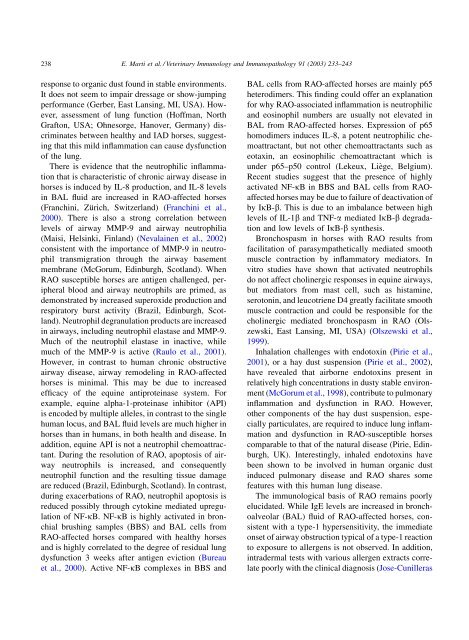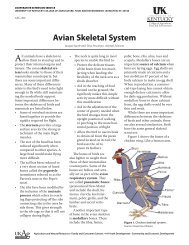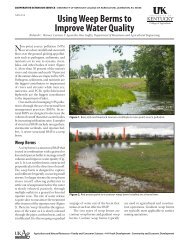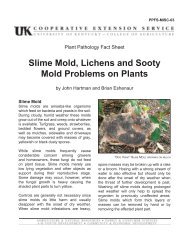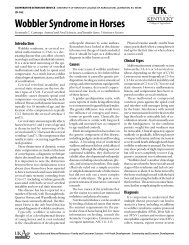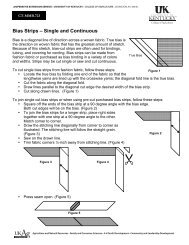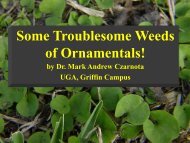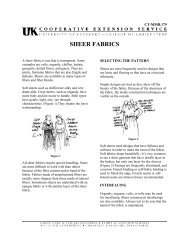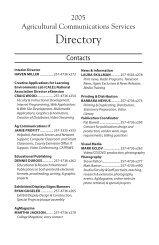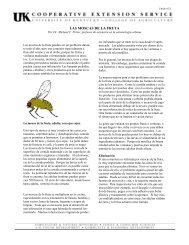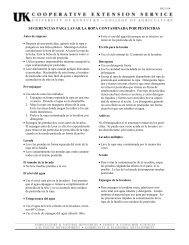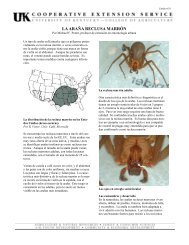Advances in equine immunology: Havemeyer workshop reports from ...
Advances in equine immunology: Havemeyer workshop reports from ...
Advances in equine immunology: Havemeyer workshop reports from ...
You also want an ePaper? Increase the reach of your titles
YUMPU automatically turns print PDFs into web optimized ePapers that Google loves.
238 E. Marti et al. / Veter<strong>in</strong>ary Immunology and Immunopathology 91 (2003) 233±243<br />
response to organic dust found <strong>in</strong> stable environments.<br />
It does not seem to impair dressage or show-jump<strong>in</strong>g<br />
performance (Gerber, East Lans<strong>in</strong>g, MI, USA). However,<br />
assessment of lung function (Hoffman, North<br />
Grafton, USA; Ohnesorge, Hanover, Germany) discrim<strong>in</strong>ates<br />
between healthy and IAD horses, suggest<strong>in</strong>g<br />
that this mild <strong>in</strong>¯ammation can cause dysfunction<br />
of the lung.<br />
There is evidence that the neutrophilic <strong>in</strong>¯ammation<br />
that is characteristic of chronic airway disease <strong>in</strong><br />
horses is <strong>in</strong>duced by IL-8 production, and IL-8 levels<br />
<strong>in</strong> BAL ¯uid are <strong>in</strong>creased <strong>in</strong> RAO-affected horses<br />
(Franch<strong>in</strong>i, ZuÈrich, Switzerland) (Franch<strong>in</strong>i et al.,<br />
2000). There is also a strong correlation between<br />
levels of airway MMP-9 and airway neutrophilia<br />
(Maisi, Hels<strong>in</strong>ki, F<strong>in</strong>land) (Nevala<strong>in</strong>en et al., 2002)<br />
consistent with the importance of MMP-9 <strong>in</strong> neutrophil<br />
transmigration through the airway basement<br />
membrane (McGorum, Ed<strong>in</strong>burgh, Scotland). When<br />
RAO susceptible horses are antigen challenged, peripheral<br />
blood and airway neutrophils are primed, as<br />
demonstrated by <strong>in</strong>creased superoxide production and<br />
respiratory burst activity (Brazil, Ed<strong>in</strong>burgh, Scotland).<br />
Neutrophil degranulation products are <strong>in</strong>creased<br />
<strong>in</strong> airways, <strong>in</strong>clud<strong>in</strong>g neutrophil elastase and MMP-9.<br />
Much of the neutrophil elastase <strong>in</strong> <strong>in</strong>active, while<br />
much of the MMP-9 is active (Raulo et al., 2001).<br />
However, <strong>in</strong> contrast to human chronic obstructive<br />
airway disease, airway remodel<strong>in</strong>g <strong>in</strong> RAO-affected<br />
horses is m<strong>in</strong>imal. This may be due to <strong>in</strong>creased<br />
ef®cacy of the equ<strong>in</strong>e antiprote<strong>in</strong>ase system. For<br />
example, equ<strong>in</strong>e alpha-1-prote<strong>in</strong>ase <strong>in</strong>hibitor (API)<br />
is encoded by multiple alleles, <strong>in</strong> contrast to the s<strong>in</strong>gle<br />
human locus, and BAL ¯uid levels are much higher <strong>in</strong><br />
horses than <strong>in</strong> humans, <strong>in</strong> both health and disease. In<br />
addition, equ<strong>in</strong>e API is not a neutrophil chemoattractant.<br />
Dur<strong>in</strong>g the resolution of RAO, apoptosis of airway<br />
neutrophils is <strong>in</strong>creased, and consequently<br />
neutrophil function and the result<strong>in</strong>g tissue damage<br />
are reduced (Brazil, Ed<strong>in</strong>burgh, Scotland). In contrast,<br />
dur<strong>in</strong>g exacerbations of RAO, neutrophil apoptosis is<br />
reduced possibly through cytok<strong>in</strong>e mediated upregulation<br />
of NF-kB. NF-kB is highly activated <strong>in</strong> bronchial<br />
brush<strong>in</strong>g samples (BBS) and BAL cells <strong>from</strong><br />
RAO-affected horses compared with healthy horses<br />
and is highly correlated to the degree of residual lung<br />
dysfunction 3 weeks after antigen eviction (Bureau<br />
et al., 2000). Active NF-kB complexes <strong>in</strong> BBS and<br />
BAL cells <strong>from</strong> RAO-affected horses are ma<strong>in</strong>ly p65<br />
heterodimers. This ®nd<strong>in</strong>g could offer an explanation<br />
for why RAO-associated <strong>in</strong>¯ammation is neutrophilic<br />
and eos<strong>in</strong>ophil numbers are usually not elevated <strong>in</strong><br />
BAL <strong>from</strong> RAO-affected horses. Expression of p65<br />
homodimers <strong>in</strong>duces IL-8, a potent neutrophilic chemoattractant,<br />
but not other chemoattractants such as<br />
eotax<strong>in</strong>, an eos<strong>in</strong>ophilic chemoattractant which is<br />
under p65±p50 control (Lekeux, LieÁge, Belgium).<br />
Recent studies suggest that the presence of highly<br />
activated NF-kB <strong>in</strong> BBS and BAL cells <strong>from</strong> RAOaffected<br />
horses may be due to failure of deactivation of<br />
byIkB-b. This is due to an imbalance between high<br />
levels of IL-1b and TNF-a mediated IkB-b degradation<br />
and low levels of IkB-b synthesis.<br />
Bronchospasm <strong>in</strong> horses with RAO results <strong>from</strong><br />
facilitation of parasympathetically mediated smooth<br />
muscle contraction by <strong>in</strong>¯ammatory mediators. In<br />
vitro studies have shown that activated neutrophils<br />
do not affect chol<strong>in</strong>ergic responses <strong>in</strong> equ<strong>in</strong>e airways,<br />
but mediators <strong>from</strong> mast cell, such as histam<strong>in</strong>e,<br />
seroton<strong>in</strong>, and leucotriene D4 greatly facilitate smooth<br />
muscle contraction and could be responsible for the<br />
chol<strong>in</strong>ergic mediated bronchospasm <strong>in</strong> RAO (Olszewski,<br />
East Lans<strong>in</strong>g, MI, USA) (Olszewski et al.,<br />
1999).<br />
Inhalation challenges with endotox<strong>in</strong> (Pirie et al.,<br />
2001), or a hay dust suspension (Pirie et al., 2002),<br />
have revealed that airborne endotox<strong>in</strong>s present <strong>in</strong><br />
relatively high concentrations <strong>in</strong> dusty stable environment<br />
(McGorum et al., 1998), contribute to pulmonary<br />
<strong>in</strong>¯ammation and dysfunction <strong>in</strong> RAO. However,<br />
other components of the hay dust suspension, especially<br />
particulates, are required to <strong>in</strong>duce lung <strong>in</strong>¯ammation<br />
and dysfunction <strong>in</strong> RAO-susceptible horses<br />
comparable to that of the natural disease (Pirie, Ed<strong>in</strong>burgh,<br />
UK). Interest<strong>in</strong>gly, <strong>in</strong>haled endotox<strong>in</strong>s have<br />
been shown to be <strong>in</strong>volved <strong>in</strong> human organic dust<br />
<strong>in</strong>duced pulmonary disease and RAO shares some<br />
features with this human lung disease.<br />
The immunological basis of RAO rema<strong>in</strong>s poorly<br />
elucidated. While IgE levels are <strong>in</strong>creased <strong>in</strong> bronchoalveolar<br />
(BAL) ¯uid of RAO-affected horses, consistent<br />
with a type-1 hypersensitivity, the immediate<br />
onset of airway obstruction typical of a type-1 reaction<br />
to exposure to allergens is not observed. In addition,<br />
<strong>in</strong>tradermal tests with various allergen extracts correlate<br />
poorly with the cl<strong>in</strong>ical diagnosis (Jose-Cunilleras


